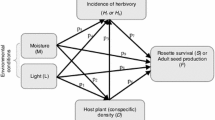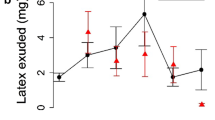Abstract
The hypothesis that cattle browsing on inflorescences of the soaptree Yucca elata reduces reproductive success was investigated by comparing recruitment and population structure in six populations protected from grazing, six grazed during the flowering season and five grazed outside the flowering season. Cattle consumed 98% of inflorescences, which were found to be highly nutritious. Reduced recruitment in flower-grazed populations could not be attributed to reduced flower survival, as recruitment in non-flower grazed populations was also reduced. Changes in population structure were due to cattle browsing small caudices, including both genets and ramets. An alternate hypothesis of limited germination in soils compacted by cattle was not supported. Cattle browsing of inflorescences reduced reproductive effort, which may be due to the inability of the plants to resorb nutrients after flowering. Browsing also increased branching, probably through lack of apical dominance, whereas physical trampling increased procumbency. Cattle browsing implies a lack of genetic recruitment, possible local extinction of the yucca moth Tegeticula yuccasella, the exclusive pollinator of Y. elata, and local reduction in insect and bird biodiversity.
Similar content being viewed by others
References
Campbell RS, Keller JG (1932) Growth and reproduction of Yucca elata. Ecology 13:364–374
Harper JL (1977) Population biology of plants. Academic Press, London
Havstad KM (1977) Effects of range site and nitrogen fertilization upon botanical and chemical content of cattle diets. Unpubl. MSc thesis, New Mexico State University Las Cruces
Herbel CH, Nelson AB (1966) Species preference of Hereford and Santa Gertrudis cattle on a southern New Mexico range. J Range Manag 19:177–181
Houghton FE (1972) Climatic guide: New Mexico State University, Las Cruces 1851–1971. New Mexico Agric Exp Stat Res Rep 230:1–20
Kearney TH, Peebles RH (1969) Arizona Flora. University of California Press, Berkeley
Kershaw KH, Looney JHH (1985) Quantitative and dynamic plant ecology, 3rd edn. Edward Arnold, Baltimore
Kingsolver RW (1986) Vegetative reproduction as a stabilizing feature of the population dynamics of Yucca glauca. Oecologia 69:380–387
McCleary JA, Wagner KA (1973) Comparative germination and early growth studies of six species of the genus Yucca. Am Midl Nat 90:503–508
Miles NJ (1983) Variation and host specificity in the yucca moth, Tegeticula yuccasella (Incurvariidae): a morphometric approach. J Lepid Soc 38:207–216
Powell JA (1989) Synchronized, mass emergences of a yucca moth, Prodoxus Y-inversus (Lepidoptera: Prodoxidae), after 16 and 17 years in diapause. Oecologia 81:490–493
Ridaura-Sanz V (1979) Towards the integral use of Yucca fillifera. In: Goodin JR, Northington DK (eds) Proceedings of the International Arid Lands Conference on Plant Resources. Texas Tech Univ, Lubbock, Texas, pp 319–325
Smith SD, Ludwig JA (1976) Reproductive and vegetative growth patterns in Yucca elata Engelm. (Liliaceae). Southwest Nat 21:177–184
Smith WE, Whitford WG (1978) Factors affecting the nesting success of the large carpenter bee Xylocopa californica arizonensis. Environ Entomol 7:614–616
Synonides E (1979) The structure and population dynamics of psammophytes on inland dunes: I Populations of initial stages. Ekol Pol 27:3–37
Van Soest PJ (1982) Nutritional ecology of the ruminant. O and B Books, Corvallis, Oregon
Zar JH (1984) Biostatistical analysis, 2nd edn. Prentice-Hall, Engelwood Cliffs, New Jersey
Author information
Authors and Affiliations
Rights and permissions
About this article
Cite this article
Kerley, G.I.H., Tiver, F. & Whitford, W.G. Herbivory of clonal populations: cattle browsing affects reproduction and population structure of Yucca elata . Oecologia 93, 12–17 (1993). https://doi.org/10.1007/BF00321184
Received:
Accepted:
Issue Date:
DOI: https://doi.org/10.1007/BF00321184




